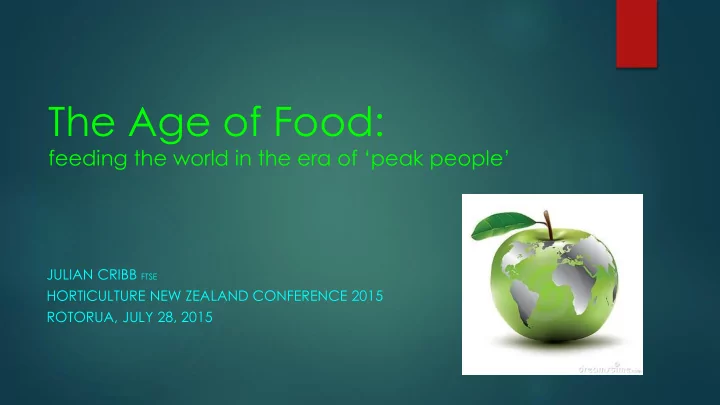

The Age of Food: feeding the world in the era of ‘peak people’ JULIAN CRIBB FTSE HORTICULTURE NEW ZEALAND CONFERENCE 2015 ROTORUA, JULY 28, 2015
Food will change ... Food will change more in the next 100 years than it has in the last 1000 2100 menu ‘unrecognisable’ to today’s consumer Change driven by: fierce supply/demand pressures global scarcities changing climates growing health and social impacts new science & technologies
A ‘wicked’ problem... DEMAND: CONSTRAINTS: ‘Peak water’ 200,000 more people/day ‘Peak land’ More babies + longer lives ‘Peak oil’ Rich eat 35,000 more meals ‘Peak Phosphorus’ Population >11 bn by 2100 ‘Peak fish’ Meat demand soaring in NICs ‘R&D drought’ Food demand +100% by 2060s ‘Capital drought’ ‘Climate extinction’
Peak water “By 2030, demand for water could be 40% greater than supply available” – UN Report, 2015. Groundwater mining Disappearing rivers Vanishing lakes Shrinking glaciers
‘As a typical meat-eating, Water in food... beer-swilling, milk-guzzling Westerner, I consume as much as a hundred times my own weight in water every day.” Food Litres to grow Fred Pearce Slice of bread 40 litres Average human uses 1386 t water / year Tomato 13 litres Cup of coffee 140 litres 100,000 t a lifetime Glass of milk 200 litres Egg 135 litres Glass of wine 120 litres Kilo of grain 1.5 tonnes Cotton T-shirt 4 tonnes 1 kg chicken 6 tonnes 1 kg grainfed beef 15 tonnes
Vanishing land “The Earth is losing topsoil at a rate of 75 to 100 GT. per year. If soil loss continues at present rates, it is estimated that there is only another 48 years of topsoil left.” - Marler & Wallin, Nutrition Security Institute 2006
Declining nutrient density of food Sources: Lindlahr 1914, USDA 1963, 1997.
Megacities: mega- risks By 2050... By 2030... 7.7 billion will live in cities Total urban area = China Urban water use 2800 cu kms Cities cannot feed themselves
'Peak oil' Food & oil prices Food and oil prices: Car numbers are in lockstep locked together: growing 7x faster than oil supplies
Why we must recycle nutrients < 30-50% of world’s food is currently wasted or lost post-harvest Peak phosphorus 5 Sources of artificial fertilisers will be scarce by 2050 >
Peak fish “The maximum wild capture fishery potential from the world’s oceans has probably been reached .” - FAO Peak fish 90% of fisheries World sea fish catch ‘fully -fished or overfished’ Source: FAO SOFIA 2014
Knowledge drought World food R&D spend 35 R&D Stagnant stagnation crop yields
Devouring a Planet Every meal costs the Planet: • 10 kilos of topsoil • 1.3 litres of diesel • 800 litres of fresh water • 0.3g of pesticide
Killer diet 2 people in 3 now die of a diet- related disease (The Lancet, 2012) Food kills 6x more people than tobacco 75% of healthcare costs linked to chronic disease F 1.4bn overweight/obese o o Diabetes: world’s 7 th largest killer d by 2030 (WHO) Food deaths are preventable deaths
Farm clearances • Global food system will wipe out 1.4 billion small farmers by 2050. • Affects all countries • 1 in 5 humans unemployed • Driven by globalisation of food chains • An area the size of Western Europe ‘land grabbed’ by investors since 2001
+ 4-5 o C warming by 2100 Climate impact Holocene climate is extinct 5 o of warming : 50% less food? on food Arable farming ‘highly vulnerable’ above 2 o Rising risk of regional famines
The challenge To more double global food output with: - half the present fresh water - less land - no fossil fuels (eventually) - unaffordable fertilisers - less technology - inadequate investment - unreliable climate. > Huge new opportunities
Urban ‘sky farms’
Intensive systems Blue Farms, Sydney MiljoGartnieret, Norway Recycled nutrients • Recycled energy • No pesticides • Bio pest control • Automated crop • management Specialty crops •
Floating greenhouses, desert farms
Green cities: climate-proof food
Re-wilding half the world
Fish farm boom Farmed fish Wild fish
Algae boom By 2050 water plants (algae) will be the world’s largest crop: health food, stockfeed, transport fuel, plastic, textiles, chemicals, paper etc
Novel foods: 26,700 edible plants http://foodplantsinternational.com
Australia’s hidden harvest... 6,100 edible Australian native plants
Cultured meat 2011: first synthetic sausage 2013: first synthetic hamburger 2020: health profiled ‘meat’
Biocultures
A new respect for food… Food Year in every junior school on Earth Teach respect for food: how to eat for health & to sustain our food supply OR ? OR?
The ‘Age of Food’
Recommend
More recommend